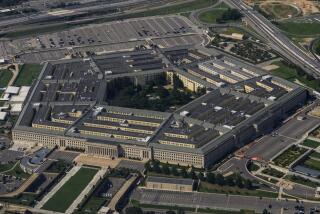Military Law Marches to Own Drummer
- Share via
The subject of military justice once again has attracted the public’s attention with the case of Air Force 1st Lt. Kelly Flinn.
Military justice has been variously described as: a contradiction in terms; too important to be left solely to the military; a secretive and arcane process that’s of limited interest to the American public; and a system supporting a structure of rank, ritual, tradition and discipline, wherein its participants can be ordered to their deaths.
In battle, it often has been noted, there is no place or show--only victory or defeat. In fact, all four choices contain elements of truth.
The court-martial confronting Flinn represents an example of the oldest federal judicial procedure in our history. Courts-martial were authorized in the Articles of War adopted by the Continental Congress in 1775-76, and thus they predate the federal district courts that were provided by the new Constitution drafted in 1787. The Articles of War functioned without major alteration until after World War II. There is no doubt that Congress originally sought to provide the military with some form of internal disciplinary authority. What remains far from clear, however, is the extent of civilian oversight intended concerning its administration.
In 1950, in the wake of unification of the military branches into one defense establishment, Congress enacted the Uniform Code of Military Justice, a federal statute that applied to all service branches. One of its truly innovative sections provided for a civilian Court of Military Appeals, with three judges (now it is five) selected by the president for limited terms and subject both to senatorial confirmation and possible reappointment. This little known appellate court has operated quietly since 1951. There is no doubt that military justice is markedly better for its presence.
During our military history prior to 1950, military justice was primarily regarded as an instrument of command. Thus the commander could select both judge and jury for a court-martial and reject their verdicts--often calling for a harsher penalty. Indeed, through improper exercise of rank, command influence could and did undermine the system. Moreover, the same military department, the Judge Advocate General Corps, functioned both as prosecutor and quasi defense counsel for the accused--with little awareness of the incompatibility between these two capacities. Frequently officers detailed as defense counsel had no formal legal training.
Now, each service has separate prosecutorial and defense branches. The commander cannot select or interfere with the military judge, nor can he call for harsher penalties; in courts-martial, prosecutors and defense counsel must be certified attorneys.
Some procedures in military justice are more advanced than in the civilian world. In spite of these very tangible improvements, contemporary military justice confronts serious perils.
The commander may still select members of the court-martial although in truth there remains no real justification for retaining this traditional role. The Court of Military Appeals is still administered by the Defense Department and its judges still lack tenure--an essential component of true judicial independence. Command influence always remains a potential evil. Most important, although certain of its decisions can now be appealed to the U.S. Supreme Court, since the 1970s that tribunal has shown a consistent and distressing lack of interest in military justice cases.
Indeed, as the years pass and members of the judiciary become less and less familiar with military justice, the greater is their tendency to accept the military viewpoint without giving it the critical, dispassionate and analytical treatment appropriate to appellate jurisprudence. Moreover, lack of scholarly civilian interest in military justice is reflected by its absence from most law school curriculums or law reviews. These trends are not healthy in a society that glorifies civilian control of the military.
Military justice is not well served under these conditions. And until the civilian bar, legal educators and the courts join in giving appropriate military justice cases the scholarly scrutiny they deserve, the situation will only get worse. Perhaps as the practitioners of military justice look for respect, they should seek it the old-fashioned way. They should earn it.


